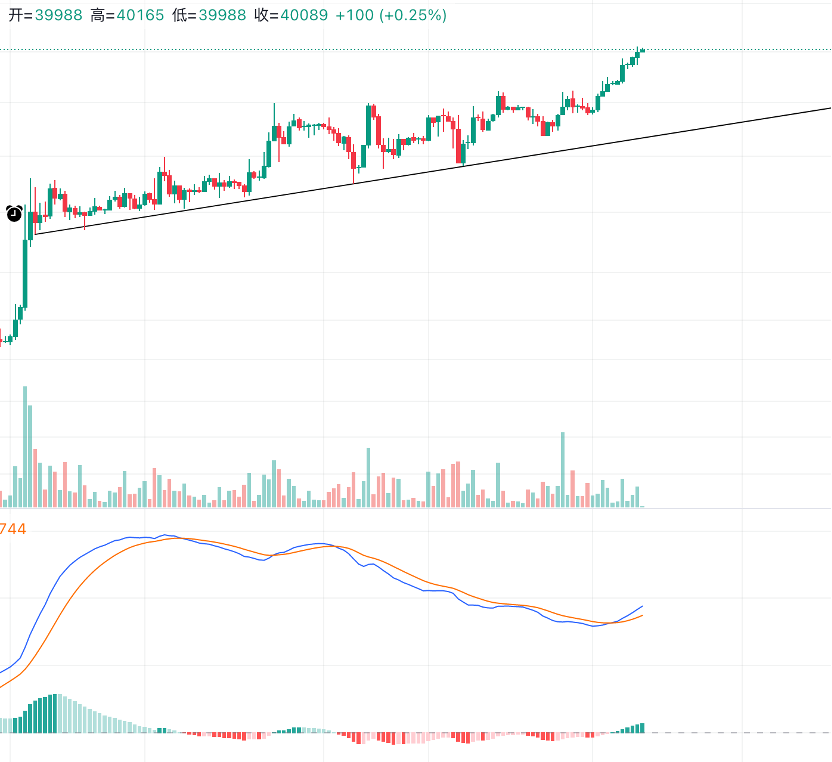The text is only a personal market view and does not constitute investment advice. If you act based on this, you are responsible for gains and losses.
Beijing trader: On-chain data user, trend trader.
The recent trend of Bitcoin is quite clear. The trend line is also very obvious. As long as it stays above the trend line, holding is the main strategy. It is not recommended to short at the top. Considering that the area around 42,000 is an important Fibonacci level, and the recent market has shown an accelerating upward trend and divergence on the daily level, selling above 42,000 is a good opportunity. The overall stop-loss level can be continuously raised along with the trend line.
The market trend is clear and there is not much to say. This kind of technical indicator divergence with an upward price trend has occurred before and is not unique to BTC. Using the trend line as a market boundary is very reliable.

Today, CME's ETH futures showed a significant gap, and this gap is against a long-term resistance line, which is worth paying attention to. If the trading volume of ETH can effectively increase today, this can be defined as a breakthrough gap, which is very favorable for the subsequent rise of ETH. The last time a breakthrough gap occurred was in January this year, when it was a breakthrough gap against the downtrend line. Based on the current price, continuing to hold ETH is a cost-effective choice. The stop-loss can be placed at the lower edge of the gap.

Finally, a personal reflection:
The biggest narrative of BTC has always been the prediction that the existing monetary system will eventually collapse after unlimited over-issuance, and BTC will then replace gold as the world currency. At least for now, the Beijing trader believes this is just a story. Perhaps we won't see any hope of realization for the next decade or two.
As global trade gradually expanded in the 20th century, crossing national borders, the internationalization of trade demanded the internationalization of finance. Therefore, the monetary system became not just an internal issue of a country, but a problem of an international monetary system. The existence of an international monetary system is primarily to serve global trade. Once, countries pegged their currency to gold, implementing the gold standard. Maintaining stable exchange rates was a primary goal. Stable exchange rates were beneficial for international trade. Although devaluation was beneficial for exports, if one country started devaluing, other countries could quickly follow suit, leading to competitive devaluation, and everyone devaluing would be equivalent to not devaluing.
However, the prevailing gold standard was eventually eliminated by the market, in part because it did not provide a basis for implementing expansionary monetary policy. The total amount of currency issuance needed to be linked to the gold reserves (the problem being that limited gold was concentrated in a few countries, and the increase in gold reserves could not keep up with the needs of the commodity economy). As labor unions gradually gained strength and began to influence political goals, maintaining stable exchange rates was no longer the primary economic goal. Controlling inflation/deflation and ensuring employment gradually became the primary goals of economic policy. This required corresponding economic stimulus, and governments needed to implement expansionary policies during economic downturns. However, under the gold standard, the limited gold reserves restricted this possibility. Countries could not simultaneously maintain stable exchange rates and achieve employment goals. In the conflict between the two, the gold standard moved towards a floating exchange rate system. Countries also adjusted currency issuance according to their own economic needs.
Artificial adjustments were not perfect and even caused more complex problems, but a return to the gold standard is still not an option today. As long as maintaining employment stability and controlling inflation/deflation remain the government's primary goals, the gold standard is unlikely to return. The concept of BTC as "digital gold" also has the same problem. Therefore, in the current social context, BTC also does not have the possibility of becoming a world currency.
So what about the future? Is it possible? The Beijing trader believes it is possible, when ensuring employment is no longer the primary goal. This requires first solving global energy and food issues. People's basic living is no longer a problem, and even the population has expanded to the point where many people do not need to work and need to be entertained in the "metaverse." At that time, the narrative of BTC as the world currency might be plausible (but still uncertain).
Saying all this is just to express the Beijing trader's view that BTC is currently just a speculative asset, a speculative asset linked to global liquidity. The infrastructure construction of the cryptocurrency industry is not yet complete, and large-scale applications are not yet widespread, still in a very early stage. The peak of the bull market in 2021 was driven by excessive global liquidity during the pandemic. Only when there is a larger scale of global liquidity or the gradual popularization of blockchain technology development/application, the Beijing trader believes that the next round of bull market is possible. Otherwise, it is just a rebound of different magnitudes and durations, which can be called a small bull market that will not reach new highs.
The 4-year bull-bear cycle no longer exists, and it did not even exist in the last cycle. The bull market of 20-21 and the superimposition of the four-year cycle are just a coincidence, and the promotion of the halving cycle is just a "consensus" that the cryptocurrency industry needs. The bull market in 2024 may not even cause much of a stir (a large amount of BTC has already been mined, and the remaining incremental supply has limited impact on the market, and limited impact is normal). The Beijing trader still has a long-term positive view on the development of blockchain technology and its applications, but just like the development of the internet, the real takeoff stage is achieved as the infrastructure gradually improves and becomes popular among the public. At that time, the imagination of price limits will be fully unleashed (but the narrative at that time should not be as a currency or currency anchor, there should be other application scenarios).
Follow me, and earn maximum trend profits with minimal operations.

免责声明:本文章仅代表作者个人观点,不代表本平台的立场和观点。本文章仅供信息分享,不构成对任何人的任何投资建议。用户与作者之间的任何争议,与本平台无关。如网页中刊载的文章或图片涉及侵权,请提供相关的权利证明和身份证明发送邮件到support@aicoin.com,本平台相关工作人员将会进行核查。




